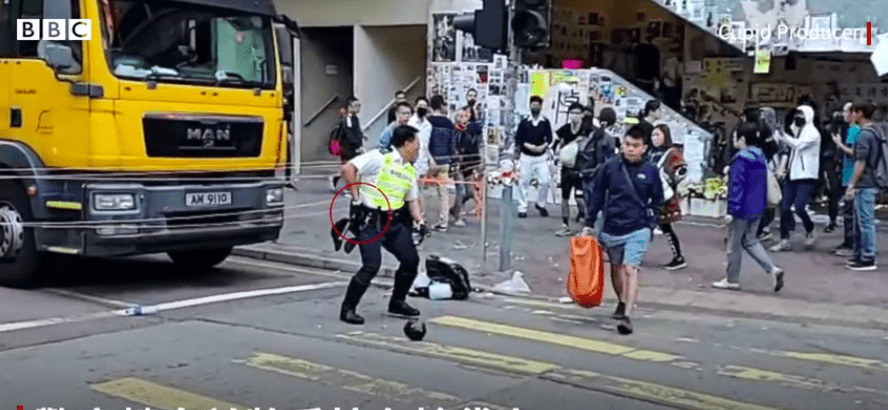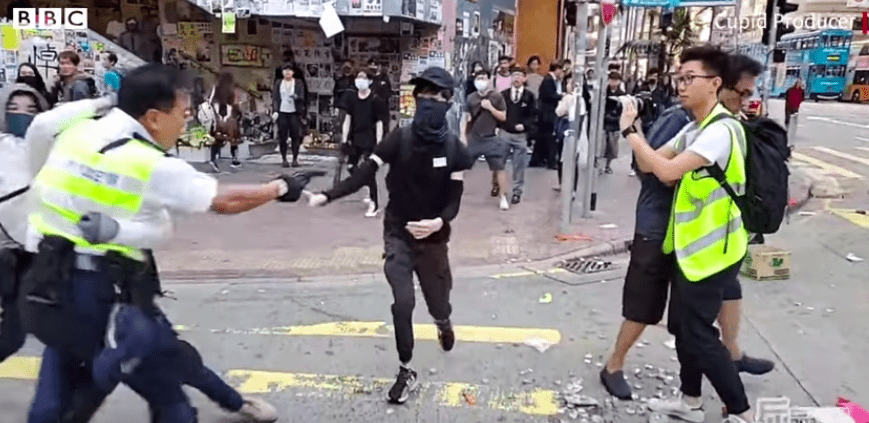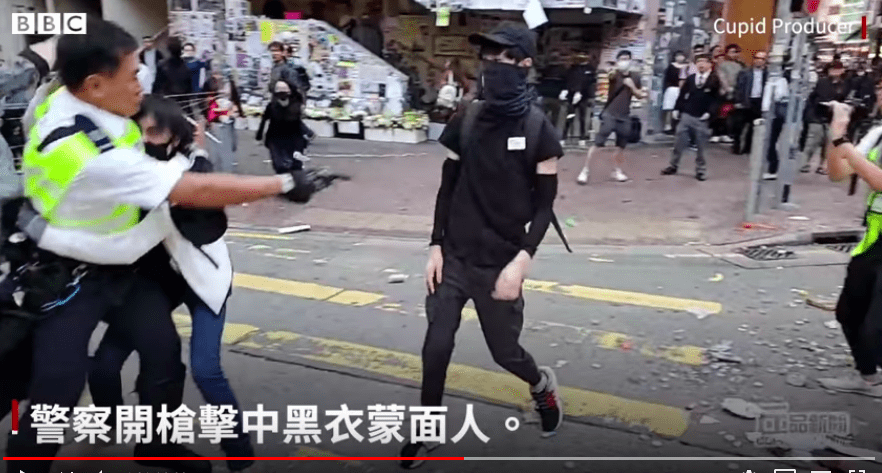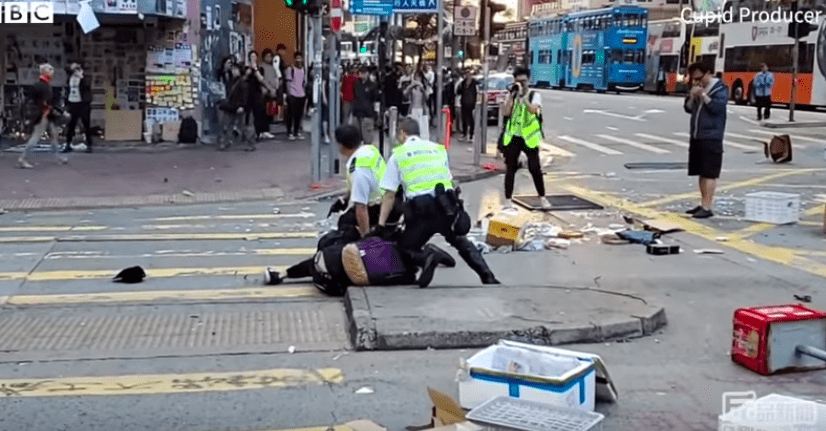Hong Kong police fired #second shot, a series of mistakes
When I wrote about the shooting of the Hong Kong police, although I added the prefix "Shooted by the Hong Kong police", I did not intend and do not hope that there will be a second article about the shooting of the Hong Kong police. However, as many observers feared, the window has been broken. If the Hong Kong government and the police force do not take strong countermeasures for the second shot, it is only a matter of time before the third shot arrives. The shooting of the Hong Kong police has already made people angry, and the overwhelming slander on the Internet (especially the CCP media) has made people angry. Although I don't want to, I can only write a sequel to the Hong Kong police shooting to condemn police violence and fight back against online smears. Although there is little hope, I hope this will be the end of the Hong Kong shooting.
If the first shot of the Hong Kong police still has room for discussion, and the Hong Kong police still have a little space to defend themselves, this second shot is undoubtedly a complete mistake. These series of errors would not have led to the current result if one or more of them did not occur. However, either because of his own lack of training or out of an irrational mentality of seeking revenge, the policeman just completed all the wrong steps and staged a second tragedy on the streets of Hong Kong.
The video is as follows
Mistake #1 Inappropriate handling of verbal conflict

It can be seen from the video that the traffic policeman had already completed his affairs and was about to leave the scene. But because of the words coming from behind, he suddenly turned around and turned back.
Since the Occupy Central Movement in 2014, it is not uncommon for the Hong Kong police to face verbal conflicts and even insults from the public during law enforcement. In this regard, the Hong Kong Police Force issued guidelines to police officers on handling abusive behaviors by the public on March 17, 2014. The Secretary for Security, Mr Lai Kwok-tung, gave the following answers when questioned by the Legislative Council
1) and (2) Police officers will make professional judgments on the circumstances of each case, and will handle and respond appropriately according to the conduct of the person concerned and the nature of the report/complaint. The guidelines remind police officers to exercise restraint and patience in the face of abusive or uncooperative attitudes from members of the public when performing their duties. If circumstances permit, officers should moderate the situation and pay attention to their speech and body language to avoid aggravating the situation.
Under the current law, abusive conduct towards a police officer does not constitute an offence. If the person who committed abusive behavior did not commit or is unlikely to commit a crime, and there is no need for police officers to follow up on the matter, police officers complete the scene work, ensure that all reasonable actions have been taken, and explain the actions of the police force After reasoning, he will leave the scene and resume his original work, such as patrolling.
It can be seen that the traffic policeman did not follow the guidelines and showed a restrained attitude towards the verbal conflicts of the citizens. Not only did he not try to ease the scene, but he turned his head and turned back to make the incident deteriorate rapidly. This error was the beginning of a series of errors.
The second mistake is to draw the gun improperly

The Hong Kong Police Force also has strict guidelines on the use of firearms by police officers. 【Discussion on Police Power】Written in the article on Police Discretion and Police General Practices
According to Section 1 of Chapter 29 of the "General Police Laws", police officers can only use force under reasonable circumstances, and can only use minimum force to achieve their goals, and they must stop after they have achieved their goals. Before the use of force, where circumstances permit, police officers should also give warnings about the use of force and its form.
In Section 2, police officers may use firearms in the following situations:
(1) To protect any person, including himself, from endangerment of life or serious bodily harm;
(2) There is reason to believe that a person has just committed a serious and violent crime that warrants arrest and/or a suspect who commits such a crime attempts to resist arrest;
(3) To quell disturbances or riots.
Section 2 also states that firearms may only be used by police officers if they cannot achieve their goals with less force. Section 3 points out that when police officers display or draw firearms as a warning, they must also comply with the provisions of Section 2 above.
It can be seen that even if the firearm is drawn out for warning or display, it still needs to meet the conditions stipulated in Section 2. It can be seen from the video that the policeman was ready to draw his gun when the man in white came over, and drew his police gun before he approached. The man in white did not see any equipment except for a mask, and no one was seriously injured at the time. The traffic policeman was in violation of the force's force guidelines by pulling his gun just because of a verbal conflict. The appearance of the second error raises the question of whether the policeman had lost his mind at the time and left professional training behind.
The third mistake, wrong enforcement

The traffic policeman's law enforcement process is very problematic. First of all, after pulling out the firearm, the general situation is to pull away and keep a distance from the other party. But the policeman stayed still and even had a tendency to move forward. Secondly, in the case of the use of firearms, the arrest should be to order the other party to make corresponding actions, and arrest the other party after the other party obeys. And for some reason, this policeman is actually taking the initiative to hug the man in white, and try to subdue such an extremely low success rate with a gun in one hand and the other, which is really surprising. It can be seen from the video that such actions not only failed to subdue the man in white, but put the policeman in an embarrassing position.
Analysis of gun grabs

It can be seen from the video that when the man in black walked towards the police and was pointed at the chest by the police, the man in black made a gesture of raising his right hand and reaching out to the side to fiddle. The Hong Kong police insisted that this was a gun grab. However, we know that when people are pointed by some objects, it is possible to subconsciously fiddle. It is difficult to judge whether the man was grabbing the gun or subconsciously. If the police chose to shoot while the man was fiddling, it would be one of many Rashomon events. However, the police did not shoot at this time
The fourth mistake, the wrong shot

It can be seen from the video that the policeman did not shoot after the man in black made a fiddle, but quickly, and the hand holding the gun subconsciously retracted behind him. Whether the police took the initiative or entangled with the man in white, the whole body was also going backwards. After the man in black took a step forward, the police took the initiative to reach forward and fired without warning.
Here we are going to review the general police rules again
Use of Force and Firearms under Chapter 29 of the Police General Regulations
(a) protect any person, including himself, from life-threatening or serious bodily harm; or
(b) execute the arrest of a suspect who has reason to believe that he has recently committed a serious violent offence and attempted to evade arrest after committing such an offence; or
(c) quelling disturbances or riots;
But at the same time, the general practice also shows that the police should exercise restraint in the use of force, and only use firearms when mild measures are ineffective.
1. Police officers must exercise self-discipline and restraint when interacting with citizens. Force shall not be used unless absolutely necessary and there is no other means of accomplishing a legitimate task.
2. Before using force, a police officer shall identify himself and, as far as the circumstances permit, give a warning to the other party, indicating the kind of force and the degree of force to be used. As far as practicable, the other party should be given the opportunity to obey the police orders before using force.
3. The principle of the use of force is that the force used must be the minimum force necessary to achieve the purpose; the use of force must be stopped immediately after the purpose has been achieved. Such force must be reasonable under the circumstances.
After the man in black did not hold any weapons and the suspected gun grab had ended, the police had no reason to shoot. No one's life is at risk, and the police can get support in a short period of time. There are quite a few options to deal with the current situation, and shooting is the most wrong and the most unacceptable one. The policeman chose to fire three shots in the downtown area when his center of gravity was unstable and he had a gun in one hand. He didn't care about the possibility of causing no injuries, which was enough to show that he had completely deviated from his training. Another man in black did not make any threatening actions during the whole process, but was also shot by the policeman, which is enough to question whether the policeman had completely lost his mind at the time.
The follow-up to the fifth mistake

After the man in black fell into a coma after being shot, the police officer instead of taking any first aid measures, bent over and pressed on the person who was shot. Afterwards, the person who was shot was moved at will and turned over. Although the police are not doctors, they should have a minimum medical knowledge of "don't move the seriously injured at will". This erroneous movement and indifference to human life is another blow to the image of Hong Kong's police force, which is scant.
Lies of the Hong Kong Police Force
The Hong Kong Police Force issued a statement saying that "at least one of them was holding a suspected iron pass", and the officer believed that "life was threatened", so he drew his gun and held it on alert. One of the masked men in white moved forward, but the police tried unsuccessfully to arrest them; another man in black walked by and tried to "grab the gun" with his right hand.
After repeatedly looking at the video, I can't find where the so-called suspected iron bucket is. The three men involved were all without weapons, backpacks, and only wearing masks. I really don't know where the police saw that they were holding a suspected iron pass. As for the so-called electro-optical flint, it is even more of a lie. The video clearly shows that the policeman drew the gun back before reaching forward and firing, which was enough time for the police to issue a warning, whether it was a shot or a verbal warning. The police force's cover-up of violent police will only further lead society to lose trust in the police force and deepen conflict and confrontation.
a little personal opinion
Since the march on June 9, the anti-extradition movement has been going on for more than five months. In addition to withdrawing the ordinance, the Hong Kong government's response was repeated tough statements in an attempt to use the police force to suppress the situation. It is precisely because of this mentality that today's police force violence is intensifying and shows no sign of being curbed. Having paid such a high price, is the movement suppressed with tear gas and bullets as the Hong Kong government expects? I am afraid that Carrie Lam himself has to admit that the intensity of the current situation is not only far more intense than that in June, but even higher than that in October. Under such circumstances, should we continue to acquiesce to the police force's abuse of violence? I also ask the Hong Kong government to think about it.
Like my work? Don't forget to support and clap, let me know that you are with me on the road of creation. Keep this enthusiasm together!

- Author
- More